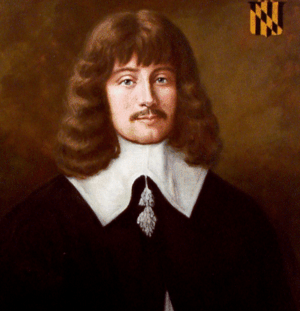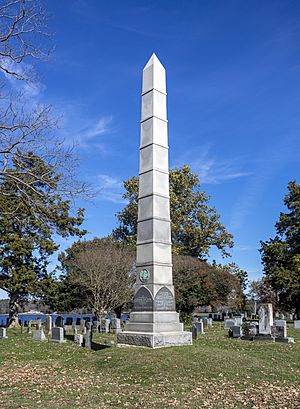Leonard Calvert facts for kids
Quick facts for kids
Leonard Calvert
|
|
|---|---|
 |
|
| 1st Proprietary-Governor of Maryland | |
| In office 1634–1647 |
|
| Preceded by | Inaugural holder |
| Succeeded by | Thomas Greene |
| Personal details | |
| Born | 1606 England |
| Died | June 9, 1647 (aged 40–41) Maryland colony |
| Children | William |
| Parents | George Calvert, 1st Baron Baltimore (father) and Anne Mynne (mother) |
| Occupation | Planter, politician |
| Signature |  |
The Hon. Leonard Calvert (1606 – June 9, 1647) was the very first governor of the Province of Maryland. This was a special type of colony called a proprietary colony. This meant it was owned by a person, not directly by the king.
Leonard was the second son of George Calvert, who was the first owner of Maryland. When his father died, Leonard's older brother, Cecil, became the new owner. Cecil then chose Leonard to be the governor of the new colony.
Contents
Early Life of Leonard Calvert
Leonard Calvert was born in 1606 in England. His parents were George Calvert, 1st Baron Baltimore and Anne Mynne. He was named after his grandfather, Leonard Calvert, who was from Yorkshire.
Trying to Settle Newfoundland
In 1625, Leonard's father, George Calvert, became Lord Baltimore. He received special permission from King James I to start a colony called the Province of Avalon. This colony was on the island of Newfoundland.
Leonard Calvert went with his father to Newfoundland in 1628. But the colony faced many problems. There was a lot of sickness, the weather was extremely cold, and the French attacked them. Because of these issues, the family had to go back to England.
After a few years, Lord Baltimore realized Avalon wouldn't work. He then traveled to the Colony of Virginia. He found the climate there much better. However, the government in Virginia did not welcome him.
Starting the Maryland Colony
In 1632, Lord Baltimore went back to England. He talked with King Charles I about getting permission for a new colony in America. This new colony would be called Maryland. Sadly, before all the paperwork was finished, Lord Baltimore died on April 15, 1632.
On June 20, 1632, his son, Cecil, became the new Lord Baltimore. King Charles I gave Cecil the official document, called a charter, for the Maryland colony. This was the same charter his father had worked on.
The charter had 23 parts. The most important parts gave Lord Baltimore and his family the right to own all the land. It also gave them special powers, like those of powerful nobles in the Middle Ages. Cecil then chose his brother, Leonard Calvert, to be the first governor of Maryland.
The Ships: The Ark and The Dove
Two ships, named The Ark and The Dove, carried over 300 settlers to Maryland. They left Cowes, England, on November 22, 1633.
On February 24, 1634, they arrived at the huge Chesapeake Bay in Virginia. They explored the area for a few weeks. Then, they sailed up the Potomac River. On March 25, 1634, they landed on Blakistone Island (now called St. Clement's Island). They put up a large cross and held a Christian church service. This day is now celebrated as "Maryland Day."
Two days later, on March 27, they sailed further south. They landed near what is now St. Mary's City. This was a village of the Yaocomico people, a branch of the Piscataway tribe. The Native American chief had moved his people away to make room for the English settlers. He hoped to trade with them for their new tools and weapons. The settlers then began to build their new home there.
Leonard Calvert as Governor of Maryland
At first, Leonard Calvert tried to rule the colony all by himself, following his brother's orders. But in January 1635, he had to call a meeting of the colonists. This meeting became the first session of the General Assembly of Maryland. This was the third group of lawmakers to be set up in the English colonies.
In 1638, the Assembly made him rule according to the common law of England. After this, the power to create new laws went to the new General Assembly. This group represented the "freeholders," who were people who owned land.
In 1638, Governor Calvert took over a trading post on Kent Island. This post had been set up by William Claiborne from Virginia. In 1643, Governor Calvert went to England to talk with his brother, Lord Baltimore. He left his brother-in-law, Giles Brent, in charge.
Calvert came back to Maryland in 1644 with his new wife and children. His son William was born in 1643, and his daughter Anne in 1644. That same year, Claiborne returned and led a rebellion. Many Protestant colonists in Maryland rose up against the Catholic owner. Calvert was forced to escape to Virginia. But he came back in 1646 with an armed group. He took back control of the colony for the owner.
Leonard Calvert became sick and died in the summer of 1647. Before he died, he wrote his will. He named Margaret Brent as the person to handle his affairs. Margaret Brent was Giles's sister and later became a famous planter and lawyer. Calvert also chose his friend, Thomas Greene, to be the next governor. Thomas Greene had traveled with him on The Ark and The Dove.
In 1890, the State of Maryland built a tall monument for Calvert and his wife. It is in Historic St. Mary's City. This area is now a historical district that remembers the colony's beginnings.
Searching for Leonard Calvert's Lost Grave
No one knows exactly where Leonard Calvert's grave is today. But there is a project trying to find it. Archeologists who work at the Historic St. Mary's City research center believe he is buried somewhere in St. Inigoes, Maryland.
They think the most likely spot is on Webster Field. This is a small U.S. Naval Aircraft facility near the water in St. Inigoes. Several archeological digs have been done there, but they haven't found the grave yet.
Some members of the Calvert family were buried in lead coffins. It is not known if Leonard Calvert was buried this way. He died suddenly from an illness. His death happened after a time of religious fighting in the colony. Soon after he died, one of the first laws requiring religious tolerance was written. This law helped bring peace back to the colony.



